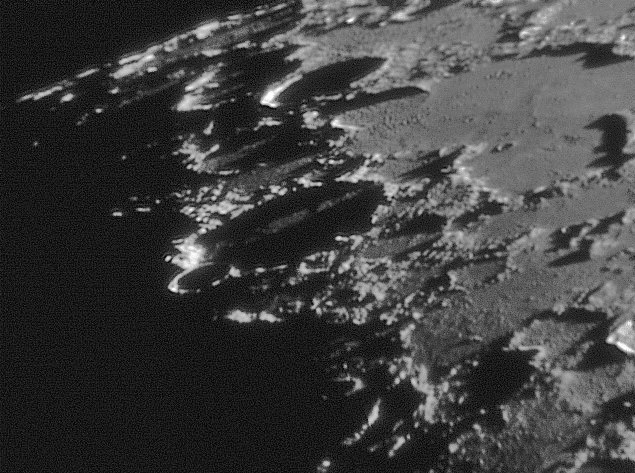May 13, 2008
Shafted!

image by Helmut Gröll, Moers, Germany
A recent LPOD Photo Gallery upload provides this shaft of light view of the floor and western wall of Barrow at 70°N. To the north a similar diverging band of brightness crosses Scoresby M, and poleward of that another is in Challis. The Barrow beam is even more engaging because a rim peak of Meton C, to its east, casts a shadow in line with the bright shaft. This looks almost like runway lights leading toward a safe landing spot. (Please, UFOologists, don't mistake my simile for an interpretation!)
Chuck Wood
Technical Details
05/11/2008 2052UT. 10"-Newton, DMK 21AF04.AS
Related Links
Rükl plate 4
Helmet's webpage
Yesterday's LPOD: Panoramic Sweep of Delicate Details
Tomorrow's LPOD: Goodacre's Take
COMMENTS
(1) The Moon is a fascinating place--but it would be even MORE interesting if it were in fact filled with huge jagged, razor-sharp mountains and crater walls that seem so apparent in images like this taken with low-angle lighting. I would really enjoy a Moon like that! Perhaps when we return to the surface of the Moon, panoramic photos taken from deep inside craters will treat us to some of the drama imagined by Moon artists back in the 1950s.
--Bill
(2) Giving the time and place from which a lunar observation was made (as is done here) adds greatly to its usefulness. In the present case it permits a more careful interpretation of the shadows. The increase in their lengths going from right to left across the frame is, of course, more a function of the sun angle getting lower than of the terrain getting more rugged. One can deduce that the rim peak of Meton C casting the shadow pointing towards the gap in the wall of Barrow must stand about 1450 m above its surroundings (a Lunar Orbiter photo taken 40 years earlier puts the figure -- measured to a slightly different end point -- at 1470 m). This is very similar to the heights deduced from the shorter shadows cast by the rim peaks on the other side of Meton C (the tallest of which is probably about 1500 m). By the time one gets to Barrow, the sun is low enough that a rim peak of just slightly over 1000 m would be sufficient to cast a shadow completely across the floor. Tracing back along the direction of the Sun's rays from the wide end of the Barrow shaft, one can deduce that the V-shaped shaft comes from a roughly 15 km long segment of Barrow's rim centered on the point where it goes essentially down to the level of the mare (just like the pointed dark shadows from the peaks, the pointed-ness of the "bright shadow" from the notch results from its slope, rather than from a fanning of the sunlight). According to Lunar Orbiter IV Frame 116H, the gap itself is no more than about 1 km wide. Rising 1000 m in about 8 km means that to a person standing on Barrow's floor, the rim would rise at a relatively gentle slope of about 7° on either side of the low point. Helmut's photo also appears to show the shaft fading into darkness at a point on Barrow's west floor very close to the theoretical terminator position (the point where the Sun's rays would be expected to be tangent to the Moon's curve), probably indicating that Barrow's floor follows rather closely the Moon's overall spherical shape with some minor deviations indicated by the undulations of brightness. For example, the relatively large break in the shaft a little to right of the floor's center would require a rise of 75-100 m over a distance of 4-5 km. That's a slope (~1°) too small to be noticed in most photos taken with the Sun at a higher angle. -  JimMosher
JimMosher
(3) Jim--I enjoyed your analysis of the shadows. It certainly adds value and perspective to the image.
--Bill
COMMENTS?
Register, Log in, and join in the comments.



